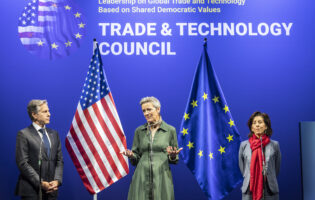German Space Exploration and International Cooperation

Colleen Anderson
Harvard University
Colleen Anderson was a DAAD/AICGS Research Fellow at AICGS in July and August 2016. She is a sixth-year PhD candidate in the history department at Harvard University, focusing on the history of Germany, the Cold War, and technology. She is especially interested in the history of Germany within the wider context of Europe and the transatlantic world.
Her dissertation examines outer space exploration in East and West Germany, both in terms of German participation in space research and Germans’ imaginations about the possibilities for outer space travel. She looks at the period from the foundation of the two states in 1945 through German Reunification in 1990.
At AICGS, she will bring her dissertation project into contemporary space exploration. In particular, she will look at the role of German space exploration in the twenty-first century, especially within the European Space Agency (ESA). In recent years, German and European space scientists have faced new challenges and new opportunities. The termination of NASA’s Space Shuttle program ended a significant avenue for manned space travel. At the same time, the ESA is expanding its own research, seen most dramatically in the 2014 comet landing of the Philae lander. In addition to these new scientific opportunities and challenges, this project also contextualizes popular support for space travel within a longer history of postwar German involvement in European space endeavors.
On September 30, 2016, the Rosetta space mission came to an end. The mission, run by the European Space Agency (ESA), represented one of the most dramatic space achievements in recent years. Two years ago, in August 2014, the Rosetta spacecraft first rendezvoused with its target: the comet 67P/Churyumov-Gerasimenko, which was at the time 539 million kilometers from the Sun. In November of that year, Rosetta’s Philae lander fulfilled the main goal of the mission, touching down on the comet’s surface.
In the recent discussions following the end of the mission, members of ESA emphasized the cooperation among scientists across Europe that had spanned decades, which made the mission possible. Alvaro Giménez, the ESA director of science, said that the mission was completed “thanks to a huge international, decades-long endeavour.”[1] But where did this cooperation come from?
Looking back at the history of space travel, the Space Race between the U.S. and Soviet Union stands out as a major moment. Yet the Space Race was more about competition than cooperation. However, for East and West Germany at the time—and also for Germany today—collaboration was a crucial part of space exploration. Moreover, this history of collaboration is important when thinking about East Germany (the GDR) and West Germany (the FRG) and also contemporary German space ventures.
Cooperation was necessary for German space experiments in the years immediately following the end of the Second World War. In the early 1940s, the German rocketry program had been the most advanced rocketry program in the world, especially because of the V-2 rocket. This rocket was the first rocket to reach outer space, but it also brought significant destruction to western Europe, killing thousands of civilians and military personnel in western Europe and tens of thousands of forced laborers who made the weapon.[2] The end of the war brought German rocketry to a halt. First, the Allies banned German rocketry experiments in all of the occupied zones, to prevent the reconstitution of the V-2 program. Second, in the postwar period, there were relatively few rocket scientists left in the country. The U.S. and to a lesser extent the USSR had taken Germany’s great rocket scientists back to work on their own national space programs.[3] Yet enthusiasts were not deterred. In these early years, German space enthusiasts, such as the Society for Space Travel (Gesellschaft für Weltraumforschung), worked with other enthusiasts across western Europe and around the world to circumvent these impediments.
East and West Germans also imagined the possibilities for space cooperation during these early years. While East and West Germany were on the sidelines to the more dramatic competition between the U.S. and Soviet Union in the 1950s and 1960s, East and West Germans were thinking about a future in which space exploration was international. The 1960 East German blockbuster film Der schweigende Stern (The Silent Planet) told the story of a crew that flies to Venus to prevent the inhabitants of the planet from attacking Earth.[4] The film, which was a hit in the GDR, featured an international crew. The commander was from the USSR, and the crew was from the U.S., Germany, Poland, China, Japan, India, and an unnamed country in Africa. In the film, the crew put aside their national differences to save humanity.[5]
The same theme of cooperation appeared in West German thought on space travel. The television show Raumpatrouille (Space Patrol) premiered on West German television in September 1966, which was only one week after Star Trek premiered in the U.S. This show featured an international crew, hailing from the U.S., Sweden, Italy, Japan, France, and the Soviet Union, which patrolled the borders of humanity’s vast galactic empire. Like the collaboration seen within the crew’s makeup, the creation of the television show itself was also cooperative, made in conjunction with a French production team. Once again, outer space was a place for international cooperation with a common goal—to protect Earth.[6] Although both The Silent Planet and Space Patrol premiered during the Space Race, East and West German screenwriters alike emphasized that space was a place for cooperation between states.
This desire for collaboration became a reality once East and West German scientists began participating in space exploration starting in the 1960s and especially in the 1970s.
In East Germany, starting in the 1960s, the East German Academy of Sciences sponsored over half a dozen space projects, almost exclusively in collaboration with the USSR. These projects focused on the study of the cosmos, meteorology, and the development of communications. In 1975, eastern European space cooperation was formalized through the Interkosmos program. Interkosmos, which was sponsored by the Soviet Union, allowed scientists from Warsaw Pact countries and also from other states sympathetic to the USSR, such as Cuba, Vietnam, and even France, to gain access to Soviet know-how and technology in order to create and launch their own national space experiments.[7]
The most important contribution of the GDR to the Soviet space program was in the field of optics, which were largely produced at the East German optics firm Carl Zeiss Jena. The Soviet space program began speaking with Carl Zeiss Jena about space cameras in 1975 to produce a space camera that could study land, resources, and ironically for the socialist countries, environmental protection.[8] By 1976, a team of East German and Soviet specialists had produced the MKF-6 camera, a multispectral camera with six lenses. When combined, the photographs offered a detailed view of the topography.[9]
The success of the camera paved the way for the first East German cosmonaut, Sigmund Jähn, who flew in 1978. Beyond the benefits that the camera brought to East German space exploration, the East German Academy of Sciences also hoped that the camera would allow for cooperation with other states, especially by selling the camera, its pictures, and also the expertise needed to develop the film around the world. For the GDR, outer space collaboration offered East Germany the opportunity to have a role on the international stage and also to increase its participation working with other states around the globe. Especially, outer space was a way to improve East Germany itself, whether through better negotiating power with the USSR or through increased international relations.
This approach in the GDR contrasted with the understanding of space cooperation in the Federal Republic. West German scientists and politicians saw an enormous benefit in space collaboration both for West Germany and for European integration.
West German scientists and space engineers worked on three fronts. First, following the end of the rocketry ban in May 1955, West Germans developed several space organizations, including the DFVLR (German Test and Research Institute for Aviation and Spaceflight). In 1997, the DFVLR became the DLR, the Deutsches Zentrum für Luft- und Raumfahrt, which is the current German Aerospace Center. Second, West German scientists cooperated on NASA missions and built equipment for NASA, especially starting after the end of the Apollo moon program in the early 1970s. Finally, West German space scientists and engineers worked within larger international institutions, especially within Europe. One of the first European organizations was ESRO, the European Space Research Organization, which was founded in 1964 by ten western European states, including West Germany. In 1975, the European Space Agency (ESA) was formed out of ESRO. ESA worked and continues to work in designing, building, launching, and maintaining space vehicles and experiments. It observes Earth and works with satellite telecommunications, in addition to carrying out scientific experiments. ESA has its own launching capabilities, and starting in the 1980s has had its own astronaut training program. Plans for an ESA space vehicle like the space shuttle began in the 1970s, but funding caused the plan to be abandoned in the early 1990s.
During much of the Cold War, West Germany was the second-largest financial contributor to ESA, after France. Importantly, the FRG prioritized funding for European space activities over its own national program, contributing approximately two times more to the European program than to the German national program.[10] Other states did not spend such a proportion on European space ventures. In 1965, France spent about 30 percent of its total space budget on European space activities.[11]
In the 1970s and 1980s, the biggest cooperative program for Germany and ESA was the Spacelab project, which was undertaken in collaboration with NASA. Spacelab was a laboratory that fit into the payload of the space shuttle. Spacelab was scheduled to be used from 1983 into the 1990s on about fifty missions, although it was only used on about twenty. Crews could enter without spacesuits and conduct scientific experiments on life sciences, Earth observation, and solar physics. Beyond its scientific importance, Spacelab was also supposed to set the tone for a new era of closer cooperation between NASA and ESA.[12]
Along with West Germany’s participation within ESA, the country had a particular connection to the Spacelab project. The contract to build Spacelab was awarded to the firm ERNO in Bremen.
In some ways, Spacelab was a success for the cooperation among West Germany, ESA, and NASA. At the time, Spacelab was the most successful ESA project by far. It had more instruments by weight on its first mission than all previous ESRO and ESA satellites combined. Moreover, it set the record for the most experiments conducted during a single spaceflight.[13]
Spacelab also showed the weaknesses in collaborating with NASA and within ESA. For instance, ESA scientists had hoped to have received more than one guaranteed spot for a European astronaut aboard the space shuttle in return for Spacelab. Furthermore, Spacelab brought out infighting within the European Space Agency. First, France and the FRG fought over whether the construction of Spacelab was the best use of ESA’s resources. ESA representatives from France wanted to prioritize building a European manned launch vehicle, while the FRG wanted to use the existing U.S. space shuttle to begin experiments more quickly. West Germany’s insistence on the Spacelab program made French delegates to ESA complain that the FRG had prioritized its relationship with the U.S. over that of Europe.[14] As a second problem, once Spacelab was built, countries fought over which experiments should be included. West Germany, France, Italy, and Belgium each tried to put as many of their own national experiments onboard Spacelab as possible. Consequently, the first Spacelab mission contained no ESA experiments. Jointly-built experiments would only fly on later missions.[15]
Spacelab showed the promises and pitfalls for international space collaboration. Outer space science allowed for scientists from across Europe and the Atlantic to work together. At the same time, it created tensions among these groups.
The history of space travel in the GDR and FRG shows that the particularities of the two states meant that they focused on different technological developments and collaborated with different groups of states. Yet East and West Germans shared a similar motivation to participate in international space research. Both East and West Germans believed that collaboration in space could help preserve peace, establish alliances, and demonstrate the development of German science more broadly. Looking at the history of East and West Germany, East German historians often depict the country as isolated, but East German scientists and ministers worked to have space exploration increase the country’s connections around the world. The example of the Federal Republic demonstrates that outer space exploration served a slightly different purpose in the FRG, as a way to unite a group of countries—even in the midst of contentions about national experiments on Spacelab.
What does this history of collaboration mean for the landscape of space exploration today? The European Space Agency has increased its visibility, including the spectacular landing of Philae in November 2014. Future plans for ESA include Euclid, which will look at energy and dark matter in the universe; Juice, which will investigate the oceans on Jupiter’s moons; and ExoMars, which will examine the Martian environment and search for signs of life. Second, the privatization of space exploration, such as SpaceX, opens the door to non-governmental participation in space research.
Today, Germany is the largest contributor to ESA after the EU and continues to send more of its space funding to the ESA than to its national space agency, the DLR. Given contemporary questions over European unity and also new space ventures, this is a moment of opportunity for Germany to continue to further European cooperation through space exploration. The strength of German leadership within the EU and its historical technological leadership in space exploration within Europe can form the foundation to tackle new challenges and opportunities in space. New problems like space debris or increasing opportunities to travel to other planets mean that there are more chances for German and European involvement, of which Germany, Europe, and also the U.S., could take advantage.
Colleen Anderson was a DAAD/AGI Research Fellow at AGI in July and August 2016. She is a sixth-year PhD candidate in the history department at Harvard University, focusing on the history of Germany, the Cold War, and technology.
[1] “Mission Complete: Rosetta’s Journey Ends in Daring Descent to Comet,” European Space Agency, n.d., http://www.esa.int/Our_Activities/Space_Science/Rosetta/Mission_complete_Rosetta_s_journey_ends_in_daring_descent_to_comet.
[2] Michael J. Neufeld, The Rocket and the Reich: Peenemünde and the Coming of the Ballistic Missile Era (New York: Free Press, 1995).
[3] Asif A. Siddiqi, Challenge to Apollo: The Soviet Union and the Space Race, 1945-1974 (Washington, DC: NASA History Division, Office of Policy and Plans, 2000), 82.
[4] Kurt Maetzig, Der schweigende Stern (DEFA Studios, 1960).
[5] Stefan Soldovieri, “Socialists in Outer Space: East German Film’s Venusian Adventure,” Film History 10, no. 3 (January 1, 1998): 382–98.
[6] Thomas W. Kniesche, “Germans to the Final Frontier: Science Fiction, Popular Culture, and the Military in 1960s Germany—the Case of Raumpatrouille,” New German Critique 101, no. 34.2 (2007): 157–85.
[7] “Der Beitrag der DDR zum ‘Interkosmos’-Programm der sozialistischen Länder (Stand 31.7.1978),” in Gemeinsamer bemannter Weltraumflug UdSSR-DDR, Presseinformation, 1978, 36.
[8] Ibid., 34.
[9] “Pressematerial über den VEB Carl Zeiss Jena,” n.d., 1, DC 9, Nr. 756, Bundesarchiv-Berlin.
[10] Niklas Reinke, Barry Smerin, and Barbara Wilson, The History of German Space Policy: Ideas, Influences, and Interdependence 1923-2002 (Paris: Beauchesne, 2007), 69.
[11] Ibid., 120.
[12] Ibid., 156–57.
[13] Ibid., 164.
[14] John Tagliabue, “Germans Control Space Tests from Hamlet,” New York Times, November 6, 1985.
[15] Reinke, Smerin, and Wilson, The History of German Space Policy, 160.








